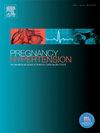Modified multiple marker aneuploidy screening as a primary screening test for preeclampsia: A validation study
IF 2.9
4区 医学
Q2 OBSTETRICS & GYNECOLOGY
Pregnancy Hypertension-An International Journal of Womens Cardiovascular Health
Pub Date : 2025-07-17
DOI:10.1016/j.preghy.2025.101239
引用次数: 0
Abstract
Objectives
Our previous case-controlled study indicates that the combination of maternal characteristics, serum placental growth factor (PlGF), and pregnancy-associated plasma protein A (PAPP-A) can predict early-onset and preterm preeclampsia with reasonable accuracy. This study aims to validate whether our preeclampsia screening algorithm can be applied to a large general obstetric population by using serum markers obtained from routine aneuploidy screening.
Study design
This retrospective cohort study analyzed maternal characteristics, serum markers, and pregnancy outcomes from pregnant individuals who underwent enhanced first-trimester screening and delivered at a Toronto tertiary center between December 2017 and June 2021.
Main outcome measures
Logistic regression was used to assess prediction accuracy and compare screening performance with algorithm from our previous case-control study. The multiple of the median (MoM) of serum markers were compared between cases and controls using Mann-Whitney U tests.
Results
The study included 340 preeclampsia cases (15 delivered < 34 weeks, 77 delivered < 37 weeks and 263 delivered ≥ 37 weeks) and 10,145 controls. Preeclampsia cases had significantly lower MoM of PlGF (0.83 vs 1.02) and PAPP-A (0.89 vs 1.07) (p < 0.0001 for both). At a 20 % false-positive rate, 80 % of early-onset, 68 % of preterm, and 58 % of term preeclampsia cases could be predicted using maternal characteristics and serum markers. Applying our previously developed algorithm achieved a comparable accuracy in this population.
Conclusion
Our findings support expanding multiple marker aneuploidy screening to include accurate, cost-effective preeclampsia risk prediction, enabling early intervention for high-risk pregnant individuals.
改良的多标记非整倍体筛选作为子痫前期的主要筛选试验:一项验证研究
目的我们之前的病例对照研究表明,结合母体特征、血清胎盘生长因子(PlGF)和妊娠相关血浆蛋白A (PAPP-A)可以合理准确地预测早发型和早产子痫前期。本研究旨在通过使用常规非整倍体筛查获得的血清标记物,验证我们的子痫前期筛查算法是否可以应用于大型一般产科人群。本回顾性队列研究分析了2017年12月至2021年6月期间在多伦多某三级医疗中心接受强化妊娠早期筛查并分娩的孕妇的产妇特征、血清标志物和妊娠结局。主要结果测量采用logistic回归评估预测准确性,并将筛选性能与我们之前病例对照研究的算法进行比较。采用Mann-Whitney U检验比较病例和对照组血清标志物中位数(MoM)的倍数。结果共纳入340例先兆子痫患者,其中分娩15例;34周,77人分娩<;37周(263例分娩≥37周)和10145例对照组。子痫前期患者PlGF的MoM (0.83 vs 1.02)和PAPP-A的MoM (0.89 vs 1.07)显著降低(p <;两者均为0.0001)。在20%的假阳性率下,80%的早发性、68%的早产和58%的足月先兆子痫病例可以通过母体特征和血清标记物来预测。应用我们先前开发的算法在这一人群中取得了相当的准确性。结论:我们的研究结果支持扩大多重标记非整倍体筛查,以包括准确、经济有效的子痫前期风险预测,从而对高危孕妇进行早期干预。
本文章由计算机程序翻译,如有差异,请以英文原文为准。
求助全文
约1分钟内获得全文
求助全文
来源期刊

Pregnancy Hypertension-An International Journal of Womens Cardiovascular Health
OBSTETRICS & GYNECOLOGYPERIPHERAL VASCULAR-PERIPHERAL VASCULAR DISEASE
CiteScore
4.90
自引率
0.00%
发文量
127
期刊介绍:
Pregnancy Hypertension: An International Journal of Women''s Cardiovascular Health aims to stimulate research in the field of hypertension in pregnancy, disseminate the useful results of such research, and advance education in the field.
We publish articles pertaining to human and animal blood pressure during gestation, hypertension during gestation including physiology of circulatory control, pathophysiology, methodology, therapy or any other material relevant to the relationship between elevated blood pressure and pregnancy. The subtitle reflects the wider aspects of studying hypertension in pregnancy thus we also publish articles on in utero programming, nutrition, long term effects of hypertension in pregnancy on cardiovascular health and other research that helps our understanding of the etiology or consequences of hypertension in pregnancy. Case reports are not published unless of exceptional/outstanding importance to the field.
 求助内容:
求助内容: 应助结果提醒方式:
应助结果提醒方式:


